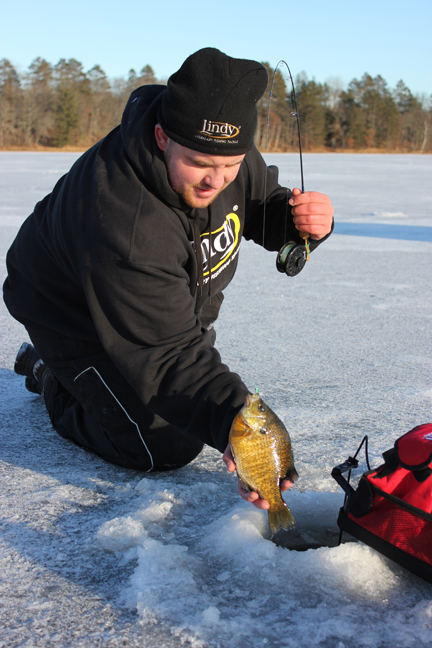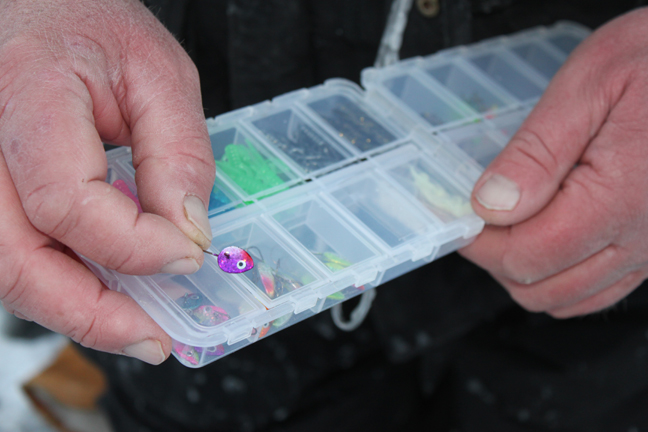 The depth finder reveals a pair of big crappies under the hole. Anxious to get the bait back down there, you let the spoon fall right to them…and they disappear. It happens all the time. Dropping jigs and spoons too fast can spook bluegills, crappies, perch and other panfish. Using aggressive colors and tactics can spook ‘em, too. We sometimes forget we’re sitting only a few feet over their heads, giving panfish every excuse to be skittish. Standing up, sitting down, scraping buckets on the ice, hovering over the hole, then allowing light to stream down there in a big beam all hamper your odds of a good day on the ice.
The depth finder reveals a pair of big crappies under the hole. Anxious to get the bait back down there, you let the spoon fall right to them…and they disappear. It happens all the time. Dropping jigs and spoons too fast can spook bluegills, crappies, perch and other panfish. Using aggressive colors and tactics can spook ‘em, too. We sometimes forget we’re sitting only a few feet over their heads, giving panfish every excuse to be skittish. Standing up, sitting down, scraping buckets on the ice, hovering over the hole, then allowing light to stream down there in a big beam all hamper your odds of a good day on the ice.
Of all these mistakes, it may be one out of our control that matters most — fishing pressure. We all know lakes that get “pounded.” Those places train panfish to develop slow and cautious reactions. The bigger a bluegill or crappie becomes, the more jigs and jigging motions it sees. They got big by being more cautious than other competitors. Those specimens tend to be taken only by the most patient competitors on top of the ice, the ones willing to slow down with packages harder for panfish to see.
On the other hand, when panfish are tightly packed, feeding competitively and being suicidal, it can be best to get down quick with a flashy spoon or brightly-colored jig and plastic combo. (Who needs bait when they’re biting the first thing that moves?) To catch more panfish in any given situation, tune into their mood first. Then tune everything else to match it.
 Tuning In
Tuning In
The weight, size, and color of a jig or spoon can be subtle or aggressive. A heavy jig is aggressive because it falls fast. A light one is subtle because it falls slower. A wide, flat spoon or jig is aggressive because it swims, flutters and sends flash in all directions. A more compact version that fishes heavy for its size can be more subtle because it has no action until you make it move.
Bright, gaudy, fluorescent and glow colors are aggressive. Panfish in an aggressive feeding mood will see them from farther away and be drawn to them. Earth tones like black, gray, brown, motor oil, smoke, pumpkinseed, watermelon and green pumpkin are subtle. They blend in, making it harder for panfish to see them. If we took a poll, we’d probably discover that most anglers think dull colors are less effective for panfish than bright chartreuse or glow orange. As a coverall statement, nothing could be farther from the truth.
Panfish can see microscopic things that you can’t. In many ways, their vision is better than yours. They train those eyes to find dull brown and olive green things all the time. A jig, spoon or plastic trailer that blends in becomes a source of intrigue. As you jig, it appears then disappears. What was that? Arousing curiosity has the effect of stirring predatory instincts, nudging a wary, less-active panfish toward a more active state.
Notice the word “natural” is avoided when describing those colors. Natural colorations of some insects, larvae and nymphs can be yellow, bright green, flame red or pure white. A metallic green jig with a chartreuse trailer can be more natural than we might suppose, while a dark color might be the most visible of all as it silhouettes against the ice.
Any selection of jigs and spoons should allow you to tune those variables of weight, shape and color to match moods of the fish. For instance, the Lindy Bug comes in two sizes. Both are panfish sizes and each size has 10 color options. The smaller version, with a size #14 hook, in one of the natural patterns like Coach Dog (black on top fading to charcoal on the belly) will “hide” in most light conditions. Its edges fade into the background, appealing to neutral fish. The larger size #12 version in chartreuse/pink glow appears twice as big and is easily seen from twice the distance, appealing to active fish.
The Lindy Toad offers the same lineup of sizes and colors in a “bottom-pounding” jig — a weight-forward design that magically retains horizontal balance. With most of the weight in front it delivers a stronger “punch” when dropped into bottom sediments than any other jig its size, creating a puffy cloud that can alternately hide, then reveal the jig, inspiring those hunting instincts in wary, pressured fish. In this case, you’re fine-tuning with shape not only to create a different profile, but to facilitate a different function.

The Lindy Bug and Toad can be fished in a subtle manner, but not the Foo Flyer. The Foo Flyer Jig has a flattened, horizontal-disc shape, designed to “fly” and cover water outside the diameter of the hole, sending flash in more directions. Even a low-energy lift-drop sends it swimming, making it a great search tool. The Foo Flyer is one of the best tools in your box when panfish are in the mood to chase.
The Foo Flyer almost has the ability of a spoon to attract, but not quite. When panfish are scattered and feeding off bottom, few things draw them in from farther away than a Lindy Frostee or Lindy Rattl’N Flyer Spoon. The surface of a spoon is always perpendicular to bottom, directing flash parallel or almost parallel to bottom — out into the murky distance you’re trying to pull panfish through. In stained or murky water, the Rattl’N Flyer adds noise, another aggressive characteristic that appeals to aggressive fish, as will the faster drop speed.
But even in dark water, blending in isn’t always a sin. The idea is to match size, color, and drop speed to the moods of the fish. The quickest way to determine those variables is with the help of plastic trailers, which can be changed quickly to play with color. Shapes can be changed to alter drop speed. Size and profile can be altered the same way, or by trimming plastic to make it smaller. All of that considered, one of the coolest things on ice for fine-tuning presentation is the Lindy Ice Jig. Each jig is packaged with 4 different, 1-inch plastic shapes in a color matching the head.
The Ice Jig comes in nine colors including black, white, purple and cranberry, which are neutral, non-aggressive shades. It also comes in chartreuse, bubble gum and various Techni-Glo shades — aggressive, “look at me” colors that appeal to active, tightly-grouped bluegills, crappies and perch. Best of all, quick experimentation with drop speed, color, size and shape eventually brings more panfish in for a look, where you can gauge their moods by their reactions to your variations.
Shy, wary, spooky fish back off from aggressive jigging, colors and fast drop speeds. Active, competitively feeding fish swim right up and nail a bright jig or spoon being snapped around. With all available information gathered on their state of mind, simply select the tool in your box that best matches that mood, and fish it in a manner that matches that mood, from quick and almost violent for aggressively feeding fish to deadstick for neutral fish.
.
